Sunday, September 10, 2006
Cooling vest 5 - building a hat with a fan
I'm trying to lower the body temperature so my neurons will fire a bit faster, thus I will think faster and better = increased IQ. Apparently this works for people with MS, see my first post on this subject. Today I'll build a hat with a fan to accomplish that. A true thinking hat! Mensa , watch out!
---
This is what cools your CPU, at least if you have an AMD powered computer. The local PC shop builds custom computers, replaces these fans with better things and sells these for under $1. It is brushless and really nice to work with as we will see.
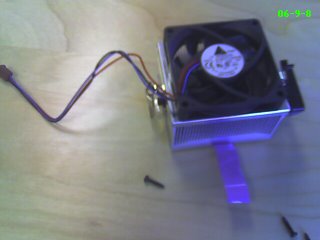
After having soldered a 9 Volt battery connector to the fan and checking that it worked, I went through my drawers and discovered this historical Microsoft Tech Ed - 97 cap. Perfect!

First I created the air-inlet with a pair of scissors.
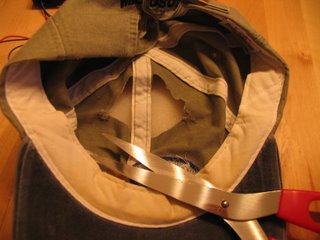
Then the fan was equipped with double sided tape in the corners so it would stay on the cap.
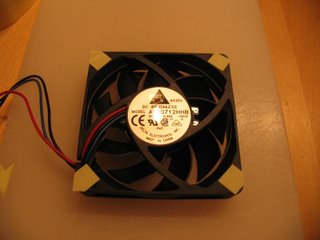
This is what it looked like when tested for the first time. It is acutally working as intended so far.

And can be worn as can be seen in this picture...

Some extra double sided tape on the battery and the cap can be worn without the battery hanging down!

Starting temperature. 36.9 degrees Celcius before putting on cap...
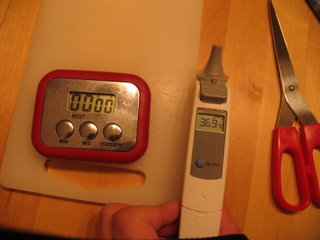
After 22 minutes the temperature is somewhat reduced, but it feels like things is not working.
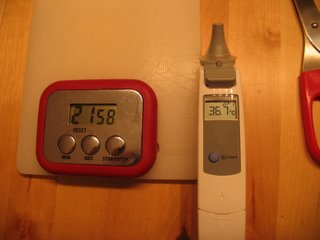
Another trial, this time the fan get's a fresh battery and spins much faster. The old one was used in a smoke-detector which had started to send out the alarm signal that the battery was almost dead. I also put ordinary tape on the side of the fan so all air would go down on the head.
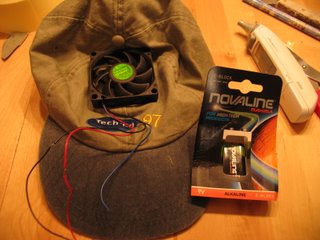
Final test result. After 69 minutes, the temperature is still 36.6 degrees Celcius.

So the temperature did not drop that much, it probably dropped that much just because I sat down and watched TV for an hour. And I really didn't feel any colder or smarter after watching TV for an hour... strange ;-)
One thing to note here is that the thermometer used can actually be pressed against the head and take a reading. All over my head it showed differenet temperatures between 34 and 35 degrees Celcius, except where the fan had been. At that place the temperature was so low that the thermometer showed just a "LOW" error message, which probably meant somewhere under 34 degrees Celcius...
Conclusion, this didn't work either, Mensa members can all calm down now, but it does seems like a fan can lower the temperature at a certain place of the body...
And it didn't feel that bad to have the fan spinning on the head. I really liked this fan, light, slim and almost soundless. (At least compared to my Laptop fan)
---
This is what cools your CPU, at least if you have an AMD powered computer. The local PC shop builds custom computers, replaces these fans with better things and sells these for under $1. It is brushless and really nice to work with as we will see.

After having soldered a 9 Volt battery connector to the fan and checking that it worked, I went through my drawers and discovered this historical Microsoft Tech Ed - 97 cap. Perfect!

First I created the air-inlet with a pair of scissors.

Then the fan was equipped with double sided tape in the corners so it would stay on the cap.

This is what it looked like when tested for the first time. It is acutally working as intended so far.

And can be worn as can be seen in this picture...

Some extra double sided tape on the battery and the cap can be worn without the battery hanging down!

Starting temperature. 36.9 degrees Celcius before putting on cap...

After 22 minutes the temperature is somewhat reduced, but it feels like things is not working.

Another trial, this time the fan get's a fresh battery and spins much faster. The old one was used in a smoke-detector which had started to send out the alarm signal that the battery was almost dead. I also put ordinary tape on the side of the fan so all air would go down on the head.

Final test result. After 69 minutes, the temperature is still 36.6 degrees Celcius.

So the temperature did not drop that much, it probably dropped that much just because I sat down and watched TV for an hour. And I really didn't feel any colder or smarter after watching TV for an hour... strange ;-)
One thing to note here is that the thermometer used can actually be pressed against the head and take a reading. All over my head it showed differenet temperatures between 34 and 35 degrees Celcius, except where the fan had been. At that place the temperature was so low that the thermometer showed just a "LOW" error message, which probably meant somewhere under 34 degrees Celcius...
Conclusion, this didn't work either, Mensa members can all calm down now, but it does seems like a fan can lower the temperature at a certain place of the body...
And it didn't feel that bad to have the fan spinning on the head. I really liked this fan, light, slim and almost soundless. (At least compared to my Laptop fan)
Tuesday, August 22, 2006
Cooling vest 4
Never give up! Talking to a co-worker about the wet cooling hat, he also recognized the potential and mentioned that they had cooled a wine-bottle with a wet towel in a boat during the summer. As the water had evaporated, the wine had chilled down. He thought it might be due to the fact that it was placed in the sun and that would remove more energy from the bottle.
Below is an example of a ceramic wine chiller, you put water in the chiller and place the bottle inside. As water passes through the ceramic, it will evaporate on the outside of the ceramic and thus cool it down as energy is taken from the chiller to the steam as the humidity will try to even out.

Here is another example of a ceramic wine chiller were the potter has not the physical insight and thus has decorated the chiller with glazing . Glaze is water tight and the chiller can not "sweat", thus it doesn't really work as intended...

Back to the hat, the cooling of a wine bottle from evaporation is not that effective since these kind of glazed wine chiller products exists and nobody seems to care.
How can we improve it?
If we blow on something it turns cold. Moving air over a hot body cools it down. So, maybe the cap needs to be blown on.
What can google dig up? Let's see... a patent?! Ohh, I'm not the first to have a go at this ;-)
Here's a link to the patent Hat with a fan
It's quite facinating to read about the improvements over other inventions in the area of hats with fans, and how the below hat is much better.
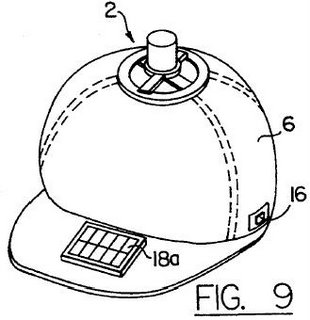
This is acutally worth testing I think... I'll try to email the innovator too see if this is in production and what his opinions are! I'll be back...
Below is an example of a ceramic wine chiller, you put water in the chiller and place the bottle inside. As water passes through the ceramic, it will evaporate on the outside of the ceramic and thus cool it down as energy is taken from the chiller to the steam as the humidity will try to even out.
Here is another example of a ceramic wine chiller were the potter has not the physical insight and thus has decorated the chiller with glazing . Glaze is water tight and the chiller can not "sweat", thus it doesn't really work as intended...
Back to the hat, the cooling of a wine bottle from evaporation is not that effective since these kind of glazed wine chiller products exists and nobody seems to care.
How can we improve it?
If we blow on something it turns cold. Moving air over a hot body cools it down. So, maybe the cap needs to be blown on.
What can google dig up? Let's see... a patent?! Ohh, I'm not the first to have a go at this ;-)
Here's a link to the patent Hat with a fan
It's quite facinating to read about the improvements over other inventions in the area of hats with fans, and how the below hat is much better.

This is acutally worth testing I think... I'll try to email the innovator too see if this is in production and what his opinions are! I'll be back...
Invention by mistake - The blogging cliff-hanger
Since I didn't have time to publish the complete experiment with the cooling hat, but left off midway, I actually got a comment asking for the final results.
Sorry about that, but my lack of time eventually leads to another great invention, "the blogging cliff-hanger".
The cliff hanger seems to have been invented by the princess in a 1001 nights according to Wikipedia
If I remember correctly Arthur Conan Doyle, published Sherlock Holmes as a cliffhanger as well. So nothing new under the sun, it just comes in a differernt shape.
Sorry about that, but my lack of time eventually leads to another great invention, "the blogging cliff-hanger".
The cliff hanger seems to have been invented by the princess in a 1001 nights according to Wikipedia
If I remember correctly Arthur Conan Doyle, published Sherlock Holmes as a cliffhanger as well. So nothing new under the sun, it just comes in a differernt shape.
Cooling vest 3
Measuring the temperature in the cap, 27.5 degrees Celcisus with a surrounding temperature of 25.4 degrees.

During the measurement period I measured the temperature, it went down a little (like 0.1 degree) but I would contribute this to the fact that I was resting, once I got up and moved around and measured it again there were no difference.
Final test results, 36.7 degrees temperature in my ear after 97 minutes.
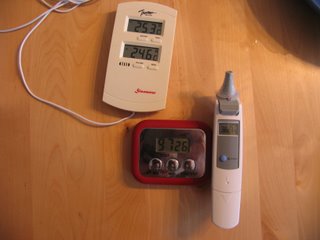
Other things I noted during the experiment was that at first it felt nice, (despite the dripping) it felt like the cold water on my head cooled me down a bit. This was not measurable with the ear thermometer, so it might just be a pleaseant feeling from the nerves in the skin.
Since all the water went down, the top of the cap got dry. It might have insulated my head and prevented heat from leaving...

Conclusions: The great idea is not really working, it really crashed and burned. There is no proof of a colder head and everything gets wet.

During the measurement period I measured the temperature, it went down a little (like 0.1 degree) but I would contribute this to the fact that I was resting, once I got up and moved around and measured it again there were no difference.
Final test results, 36.7 degrees temperature in my ear after 97 minutes.

Other things I noted during the experiment was that at first it felt nice, (despite the dripping) it felt like the cold water on my head cooled me down a bit. This was not measurable with the ear thermometer, so it might just be a pleaseant feeling from the nerves in the skin.
Since all the water went down, the top of the cap got dry. It might have insulated my head and prevented heat from leaving...
Conclusions: The great idea is not really working, it really crashed and burned. There is no proof of a colder head and everything gets wet.
Wednesday, August 16, 2006
Cooling vest 2
I'm now going to build me a cooling hat!
First I dug through the drawers and found this cap, usually used for the exact opposite purpose, that is keeping me warm...

This is my body temperature before the experiment, between 37.0 and 37.2 degrees Celcius.
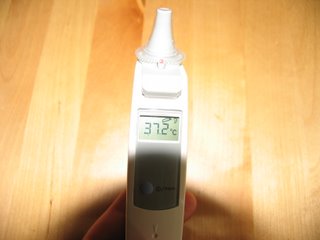
Water temperatue is 21 degrees Celcius, and room temperature is 24.8 degrees.
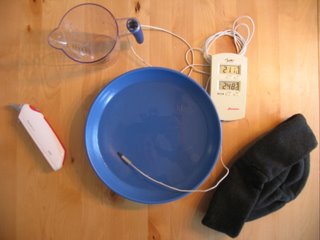
I soaked the cap in water, squeezed it so it contained two deciliters of water and put it on!
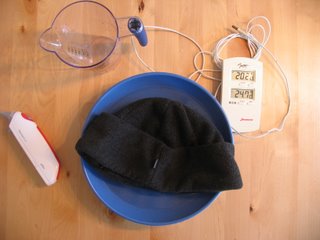
Then I sat down, turned on the TV and there was the Simpsons! Perfect!

First problem,not a major disaster but not something I had thought about. Gravity. Something that has been around since 1687. When you put on a wet cap, the water will move down from the top of the cap down to the bottom.

When to much water reaches the bottom of the cap, the cap starts dripping. First on my camera when I tilted my head forward trying to look at the camera display, and later when watching the Simpsons and resting my head on the black leather armchair it dripped down my neck and onto the armchair...

Three possible lessons learned:
First I dug through the drawers and found this cap, usually used for the exact opposite purpose, that is keeping me warm...

This is my body temperature before the experiment, between 37.0 and 37.2 degrees Celcius.

Water temperatue is 21 degrees Celcius, and room temperature is 24.8 degrees.

I soaked the cap in water, squeezed it so it contained two deciliters of water and put it on!

Then I sat down, turned on the TV and there was the Simpsons! Perfect!
First problem,not a major disaster but not something I had thought about. Gravity. Something that has been around since 1687. When you put on a wet cap, the water will move down from the top of the cap down to the bottom.
When to much water reaches the bottom of the cap, the cap starts dripping. First on my camera when I tilted my head forward trying to look at the camera display, and later when watching the Simpsons and resting my head on the black leather armchair it dripped down my neck and onto the armchair...

Three possible lessons learned:
- Too much water drips on everything.
- Keep the cap absolutely horizontal or it will drip faster in the lowest "corner".
Tuesday, August 15, 2006
Tired? get a cooling vest!
From a technical magazine "Allt om Vetenskap"I found a short notice that researchers in Sweden are evaluating cooling vests to help tired people suffering from MS. Apperantly they get tired when in a warm place and this really helps them in several ways, not just curing tiredness. The nervecells seems to communicate faster when cold!
This is just great! I need to think faster and better!!!
Googling for it, this turned up - a link to the company that sells these vests here in Sweden: Nordic BTR
It has an active water flow that regulates the temperature, so really cool!
Ok, this might be the soloution to my problems, but I can't see me hooked up to a powersupply wearing this all day.... Time for improvement, experimtenting and fun!
Sunday, August 13, 2006
Now trying out images...
Just a first test
Well, I need to post something to be able to try out the advertising stuff.....
